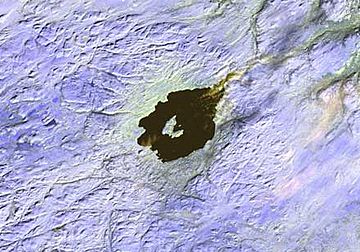Mistastin crater facts for kids
 |
|
| Impact crater/structure | |
|---|---|
| Confidence | Confirmed |
| Diameter | 19 kilometres (12 mi) |
| Age | 36.6 ± 2 million years old (Eocene Epoch) |
| Exposed | Yes |
| Drilled | Yes |
| Location | |
| Location | Labrador, Newfoundland and Labrador, Canada |
| Coordinates | 55°53′N 63°18′W / 55.883°N 63.300°W |
| Topo map | Canada NTS 13M |
| Mistastin Lake | |
|---|---|
| Coordinates | 55°53′N 63°18′W / 55.883°N 63.300°W |
| Type | Impact crater lake |
| Basin countries | Canada |
| Max. length | 19 km (12 mi) |
| Max. width | 12 km (7.5 mi) |
| Surface area | 145 km2 (56 sq mi) |
| Surface elevation | 338 metres (1,109 ft) |
| Islands | Mishta-minishtikᐡ |
Mistastin crater is a meteorite crater in Labrador, Canada which contains the roughly circular Mistastin Lake. The lake is approximately 16 km (9.9 mi) in diameter, while the estimated diameter of the original crater is 28 km (17 mi). The age of the crater is calculated to be 36.6 ± 2 million years (Eocene).
Formation and geology
Mistastin crater was created 36 million years ago by a violent asteroid impact. The presence of cubic zirconia around the crater rim suggests that the impact generated temperatures in excess of 2,370 °C (4,300 °F) (halfway that of the surface of the Sun), the highest crustal temperatures known on Earth and produced global changes that lasted for decades after the impact.
Mishta-minishtikᐡ, the lake's arcuate central island, is interpreted to be the central uplift of the complex crater structure. The target rocks were part of a batholith composed of adamellite, mangerite and lenses of anorthosite. There are abundant shock metamorphic features exhibited in the rocks of the island. Planar deformation features, diaplectic glass, melt rocks, and shatter cones have been identified.




